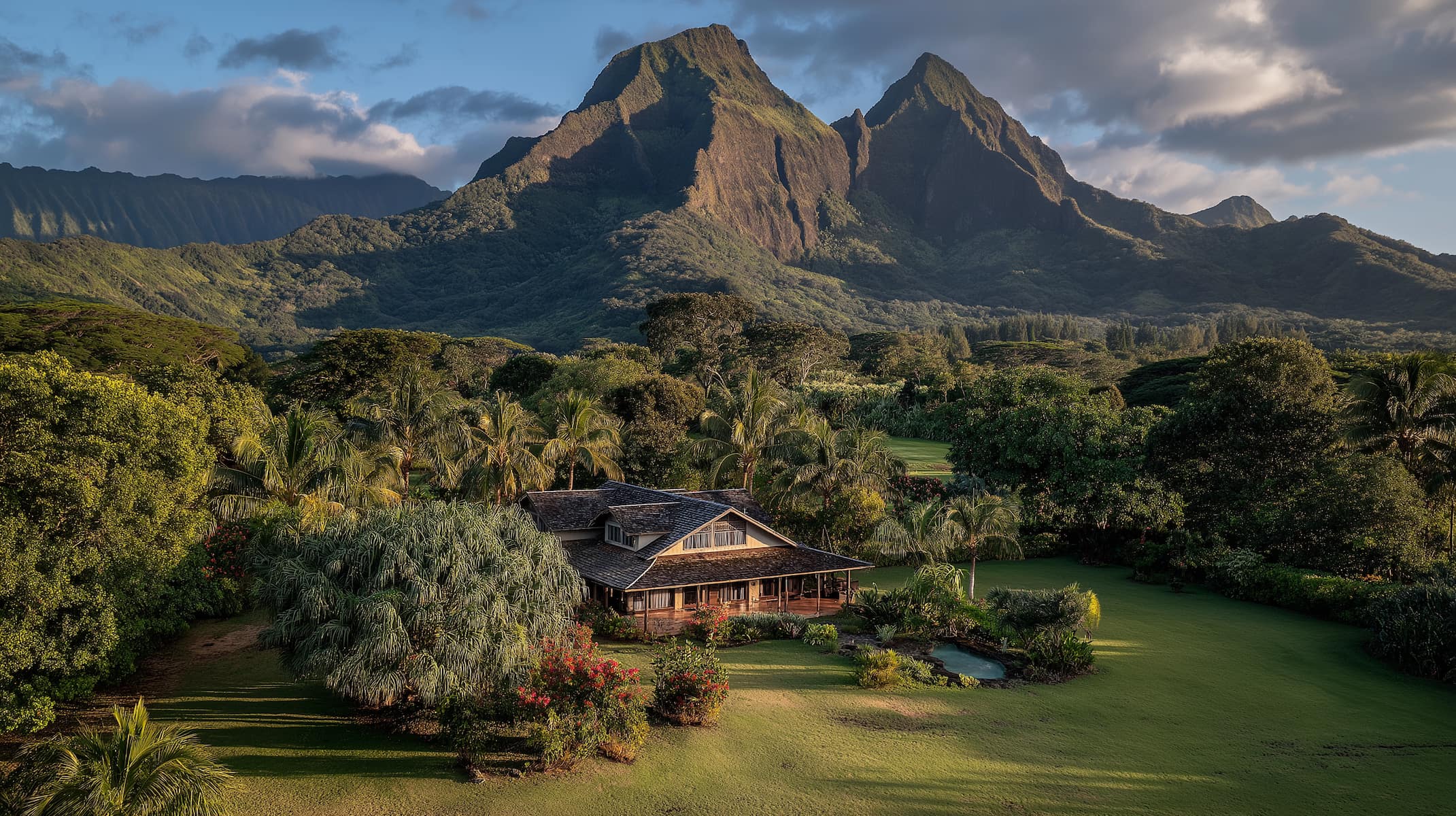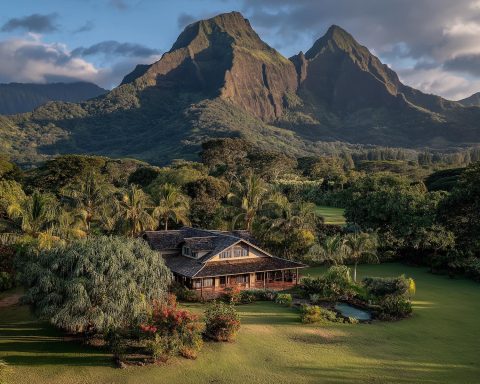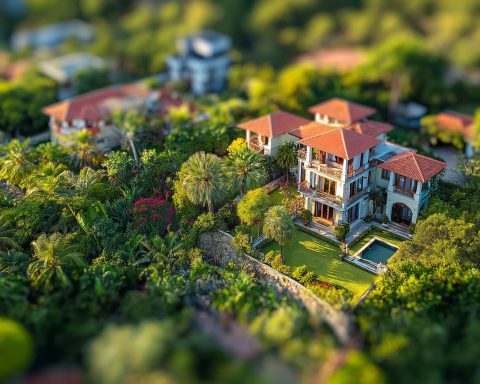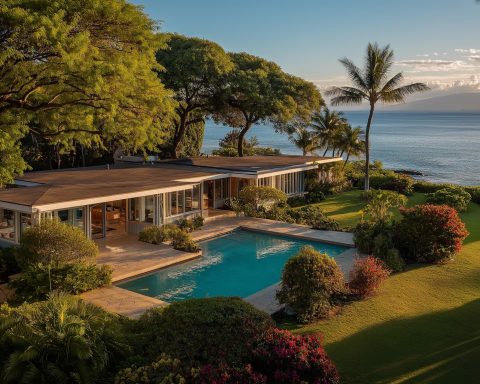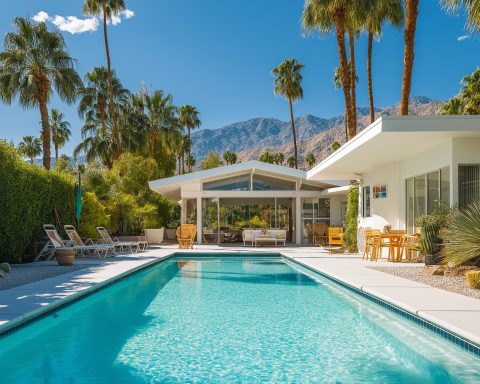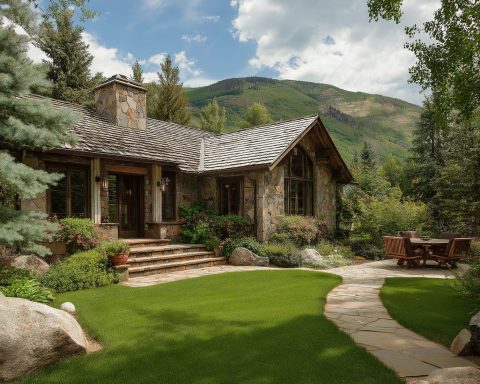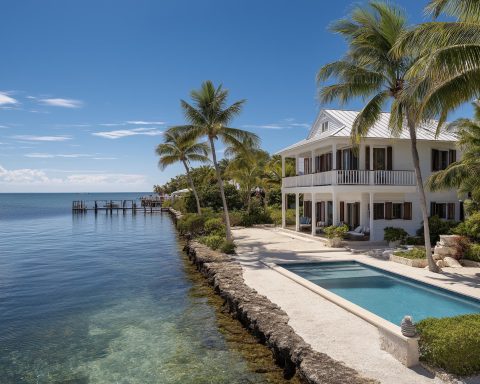Key Facts & Insights (2025 at a Glance)
- Home Prices Cooling, Still High: The typical single-family home on Kauaʻi costs around $1–1.2 million in 2025, a slight decline (~10–15% lower) from last year’s peak but still over 40% higher than pre-pandemic values locationshawaii.com hawaiibusiness.com. Condo median prices are about $685,000 (up ~4% YoY) locationshawaii.com, reflecting continued demand for more affordable options.
- Sales Volume Mixed: Single-family home sales have slowed significantly (down ~30% YoY as of August 2025) while condo sales have ticked up (~+10% YoY) locationshawaii.com. Island-wide, total home sales were actually up early in 2025 (by ~11% YoY) thanks to a burst of workforce housing sales on the South/West side hawaiilife.com, but higher-end markets like the North Shore saw fewer transactions.
- Inventory & Market Balance: After years of scarce supply, housing inventory has rebounded to 2019 levels, easing the extreme seller’s market of the pandemic era lyndagill.com. Active listings in Kauai County hovered around 440–500 homes in mid-2025, giving buyers more choices fred.stlouisfed.org fred.stlouisfed.org. Properties also take longer to sell now (e.g. median ~31 days for homes, up from ~28 days a year ago) locationshawaii.com, and price reductions are more common lyndagill.com – all signs of a more balanced, even buyer-friendly market in some segments.
- Buyer Profile: A substantial portion of Kauai purchases are by out-of-state or cash buyers. Statewide in 2024, about 20% of single-family homes and 31% of condos were bought by out-of-state buyers uhero.hawaii.edu. On Kauai, local realtors note that “more than half” of recent sales have been cash deals (buyers avoiding high interest rates) hawaiibusiness.com. Local families face affordability challenges, though new affordable housing initiatives (e.g. the Lima Ola project and upcoming Kilauea expansion) are helping some Kauaʻi residents achieve homeownership hawaiilife.com hawaiilife.com.
- Tourism-Driven Commercial Sector: Kauai’s economy remains tourism-centric, and commercial real estate reflects that. Visitor spending is forecast to dip (projected $1.6 billion decline statewide by 2026 vs. pre-2025 trend) kauainownews.com, and visitor arrivals may not fully recover until 2028 kauainownews.com. This cautious outlook tempers new resort and retail projects. Even so, key investments are underway: the historic Coco Palms Resort is being rebuilt (a 350-room Kimpton hotel slated for 2026) bigislandnow.com bigislandnow.com, and Lihue Airport is getting a $51 million upgrade to modernize its runway and safety systems by 2026 beatofhawaii.com. These projects aim to sustain tourism infrastructure without igniting over-tourism concerns beatofhawaii.com.
- Regional Contrasts: Kauai’s real estate is “not moving in one direction” uniformly hawaiilife.com. For example, the South Shore (Poʻipū/Kōloa) saw home sales double early in 2025 (boosted by a new affordable subdivision in ʻEleʻele) hawaiilife.com, which temporarily pulled median prices down ~13% island-wide hawaiilife.com. In contrast, the North Shore (Princeville/Hanalei) experienced a sales slump (–39% YoY) but prices actually rose ~10% as affluent buyers chased a limited supply of luxury properties hawaiilife.com hawaiilife.com. The East Side (Kapaʻa/Līhuʻe) and West Side (Waimea) markets fell somewhere in between – generally softer sales volume, with Līhuʻe’s median price up ~13% in mid-2025 due to its appeal to local buyers hawaiilife.com. (See regional breakdown below for details.)
- Tight Rules on Vacation Rentals: Kauai has strict short-term rental regulations – vacation rentals are legal only in designated resort zones (Visitor Destination Areas like Princeville, Poʻipū, and parts of Kapaʻa) or via grandfathered permits kauaikahuna.com. A 2024 Hawaiʻi law (SB 2919) grants counties even more power to phase out rentals in residential areas kauaikahuna.com kauaikahuna.com. While Kauai’s existing rules have kept most neighborhoods rental-free for 15+ years, this statewide push reinforces the island’s stance. Notably, the number of properties being used as vacation rentals jumped ~30% in the last year kauaikahuna.com (reflecting post-pandemic travel demand and investor interest), intensifying community pressure to enforce the rules. The result is a limited supply of legal Airbnbs and a continued tension between investment property income and local housing needs.
- Investment Outlook: Kauai offers unique opportunities – and challenges – for real estate investors. Land is scarce and highly valued, which historically means property here holds value well. However, development is not easy: community opposition often meets large projects (for instance, airport expansions beyond safety needs have been blocked due to fears of overtourism beatofhawaii.com, and the Coco Palms rebuild faced legal challenges from cultural advocates bigislandnow.com). Investors eyeing Kauai in 2025–26 will find lower frenzy than 2021 (more negotiating power as the market normalizes), but they must navigate strict zoning, high construction costs, and climate risks. In short, Kauai’s market is transitioning to a more sustainable pace, but its long-term allure – from luxury resorts to new local housing projects – suggests solid growth potential over the next 5 years if one plays the long game.
Residential Market Trends in 2025: Prices, Inventory & Buyers
Home Prices: After the frenzied run-up of 2020–2022, Kauai’s residential prices have cooled slightly but remain extremely high. As of 2025, the island-wide median single-family home price hovers around $1.1–1.2 million locationshawaii.com. This is down roughly 8–15% from last year’s median (which was ~$1.3–1.35 M) locationshawaii.com, marking the first notable dip in years. Realtors attribute the softening to rising interest rates and a shift in buyer mix – more sales in the lower-priced segments (including new affordable homes) dragged the median down hawaiilife.com. For context, even after the dip, prices are about 40–45% higher than three years prior hawaiibusiness.com, thanks to the pandemic-era surge. Condominiums on Kauai saw a different trend: the median condo price in Aug 2025 was $685,000, up ~4% year-over-year locationshawaii.com. Demand for condos (often used as vacation rentals or entry-level homes) stayed strong, and their prices “keep going up a little bit,” as one local broker noted hawaiibusiness.com. Overall, home values remain near record highs in 2025, but sellers have lost some of their pricing power as the market normalizes.
Sales Volume & Demand: Kauai’s residential sales activity in 2025 has been a mixed bag, varying by month and region. Early in the year, total transactions were up about 11% island-wide compared to the prior year hawaiilife.com – a surprising jump, given national real estate headwinds. That bump was largely due to a spike in sales on the South Shore: a new workforce housing development in ʻEleʻele (Lima Ola) allowed many local families to buy, doubling the South Shore’s sales count in one swoop hawaiilife.com hawaiilife.com. However, by the summer of 2025 the trend shifted. Through July, single-family home sales had fallen significantly (e.g. –16% island-wide median price drop and volume down, year-to-date) hawaiilife.com. By August, single-family sales were down ~30–32% year-over-year, while condo sales were up ~10% locationshawaii.com kauaipropertysearch.com. In raw terms, only 28 homes sold in Aug 2025 (vs. 41 a year prior) whereas 23 condos sold (vs. 21 prior) locationshawaii.com locationshawaii.com. This suggests a couple of things: high-end home buyers became more cautious or priced out in 2025, whereas demand persisted for condos and perhaps mid-range properties, especially those that can double as vacation rentals or second homes kauaipropertysearch.com. Buyer demand has not disappeared – properties are selling – but it has rebalanced toward more affordable products and value buys (“buyers are focusing on value” in the new market climate hawaiilife.com).
Inventory & Days on Market: One of the biggest changes in Kauai’s 2025 market is the increase in housing inventory. After an extreme drought of listings during the pandemic boom, the number of homes on the market has climbed back to roughly pre-COVID levels lyndagill.com. By mid-2025 Kauai had around 440 active listings (single-family + condo) at any given time fred.stlouisfed.org, up from the exceptionally low levels seen in 2021–22. In fact, inventory was sufficient enough that Kauai was considered a “buyer’s market” by late 2025 – supply outpaced demand in some areas, giving buyers more leverage realtor.com. Properties also sat a bit longer: the median days on market for homes rose to about 31 days (in Aug 2025, up 11% from ~28 days the year prior) locationshawaii.com, and condo market time jumped to 44 days (versus a lightning-fast 13 days a year earlier) locationshawaii.com. Realtors report seeing more price reductions and fewer bidding wars than in the recent past lyndagill.com. All of this indicates a healthier, less frantic market. However, “inventory up” doesn’t mean oversupply – it’s more that the frenzy has subsided. Many sellers are still choosing not to sell unless the price is right, since a huge number of owners enjoy sub-3% mortgage rates from prior years and have “no motivation to sell… and buy something else with a higher rate” hawaiibusiness.com hawaiibusiness.com. This has prevented any flood of inventory or steep price crash. Instead, Kauai’s housing stock is turning over at a normalizing pace, and buyers finally have a bit of breathing room to shop and negotiate.
Who’s Buying – Local vs. Outsider?: Kauai’s buyer demographics in 2025 reflect its status as a desirable but expensive market. A significant chunk of purchases are by out-of-state buyers or investors, as has long been the case in Hawaiʻi. State data from 2024 show that roughly 1 in 5 single-family homes and 1 in 3 condos statewide were sold to out-of-state buyers uhero.hawaii.edu (Mainlanders, foreign investors, etc.). Kauaʻi, being a smaller market with many luxury vacation properties, likely sees equal or higher proportions of non-local buyers. These buyers often come with cash: by mid-2023 over 50% of Kauai sales were all-cash deals hawaiibusiness.com, and that trend continued into 2025 as high interest rates made financing costly. Wealthy remote workers, retirees, and investors from the U.S. mainland (California, Pacific Northwest, etc.) remain active in Kauai’s market, drawn by the island’s beauty and relative tranquility compared to Oʻahu or Maui. On the other side, local Kauaʻi residents face steep affordability challenges – only about 20% of Hawaiʻi households can afford a median-priced home under current conditions civilbeat.org. The median household income on Kauaʻi pales in comparison to $1M home prices. Consequently, most local families either continue renting or rely on special programs and new developments to buy. The Kauaʻi County government and private partners are responding with affordable housing projects: for example, the Lima Ola affordable homes in ʻEleʻele were completed recently, allowing dozens of Kauaʻi families to purchase homes at below-market prices hawaiilife.com. And a major Kilauea Town Expansion project will break ground in 2026, adding ~310 affordable housing units for local residents on the North Shore (under a leasehold model to keep them permanently affordable) hawaiilife.com hawaiilife.com. These efforts, along with legislation to give local buyers priority (such as waitlist preferences for residents and essential workers) hawaiilife.com, aim to gradually balance the scales. In sum, 2025’s residential market sees deep-pocketed buyers dominating the high end, while Kauaʻi’s workforce and first-time buyers cautiously re-enter via targeted projects and a slightly less aggressive market.
Commercial Real Estate Outlook: Tourism, Retail and Business Trends
Kauai’s commercial real estate sector in 2025 is closely tied to the island’s tourism industry and local consumer base. After a strong post-pandemic travel rebound, Kauaʻi tourism is now hitting some speed bumps. Economists project that visitor arrivals will dip by around 4% over the next two years kauainownews.com and real visitor spending will fall by about $1.6 billion by 2026 (statewide) compared to recent highs kauainownews.com. The causes are global and national: a mild U.S. recession risk, high travel costs, and weaker international markets (Japan and Canada, key Hawaii visitor sources, saw reduced flights and currency challenges) kauainownews.com kauainownews.com. For Kauai’s hotels, resorts, and shopping centers, this implies a period of stabilization rather than rapid growth. Occupancy rates in hotels have leveled off, and room rates face pressure as hoteliers compete for fewer visitors. The commercial outlook is one of cautious optimism – tourism isn’t crashing, but it’s not expected to surge in the short term.
Retail and Hospitality: Retail spaces on Kauaʻi, especially those serving tourists (boutiques, restaurants, galleries), are experiencing a moderate but steady climate. The visitor-dependent shops in resort areas like Poʻipū and Princeville are holding their own, buoyed by the still-robust stream of U.S. mainland travelers in 2025. At the same time, local-serving retail in town centers (like Kapaʻa and Līhuʻe) has seen growth, reflecting both resident demand and tourist interest in authentic local businesses. For instance, Kapaʻa’s downtown has blossomed into a trendy spot with farmers’ markets, food trucks, and shops – Hawaii Business noted that Kapaʻa’s commercial vibrancy coincided with a doubling of home prices in that area over five years (from mid-$600Ks to around $1.2M) hawaiieliterealestate.com. Entrepreneurs are capitalizing on Kauaʻi’s unique vibe: the island has seen success stories like Kauai Brewing Company, which carved out a niche in the craft beer scene and draws both locals and visitors hawaiieliterealestate.com. Similarly, boutique wellness centers, surf schools, and farm-to-table cafes are thriving, aligning with tourists’ desire for local experiences. Big-box retail and new shopping plazas are relatively rare on Kauaʻi (in part due to community resistance to overdevelopment), but essential services (grocery stores, pharmacies) continue to do steady business. The limited commercial inventory in prime areas means occupancy rates for quality retail space remain high, even if rent growth has plateaued. Overall, Kauai’s retail market is characterized by small-scale, locally oriented businesses that benefit from tourism but aren’t solely reliant on it hawaiieliterealestate.com.
Office and Industrial Space: Unlike Oʻahu, Kauaʻi does not have a large office market – the island’s economy is less corporate and more tourism/agriculture driven. Most “office” demand comes from government agencies, medical facilities, or small professional firms. In 2025, office vacancy on Kauaʻi is low simply because supply is very limited (Līhuʻe has a handful of office buildings, and small offices are sprinkled elsewhere). There is chatter about emerging niches: for example, tech and remote work – a few tech professionals from companies like Google or Meta reportedly reside on Kauaʻi part-time, taking advantage of remote work (some sources even claimed major tech firms have a presence, though realistically it’s more likely remote workers than official offices) hawaiieliterealestate.com. This hasn’t translated into notable office development yet, but co-working spaces and better broadband have popped up to support this trend. Industrial and warehouse properties (for storage, logistics, light manufacturing) are similarly scarce but important for the local economy. The ongoing infrastructure projects (road improvements, airport upgrade) keep contractors busy and in need of yard space and warehouses. Rents for industrial space have inched up due to lack of supply.
Tourism Facilities and Hotels: The hospitality real estate segment on Kauaʻi is in a phase of renewal and reinvestment. A headline project is the Coco Palms Resort redevelopment on the East Side. Long a ghost hotel since Hurricane Iniki (1992), Coco Palms is finally being rebuilt as a 350-room luxury resort under the Kimpton brand, slated to open in 2026 bigislandnow.com bigislandnow.com. This $250–400 million project (backed by Reef Capital and IHG Hotels) is a significant investment that will create hundreds of construction jobs and, once open, hundreds of hospitality jobs bigislandnow.com. It underscores both the opportunity and challenges in Kauaʻi’s commercial scene: investors see unmet demand for high-end rooms, but the project has been controversial, with community groups trying to halt it in favor of a cultural park bigislandnow.com. A judge denied an injunction in 2024, so construction proceeds, but the developers have had to promise a “historically sensitive restoration” with a cultural center on-site to address concerns bigislandnow.com bigislandnow.com. Elsewhere on the island, existing resorts have been upgrading – for example, the former Princeville Resort reopened as 1 Hotel Hanalei Bay (after a $100M+ eco-luxe makeover) in early 2023, adding ultra-luxury inventory to the North Shore. Vacation rental condos and villa developments also form part of the commercial landscape: areas like Princeville, Kapaʻa, and Poʻipū have condo complexes that operate similarly to hotels. With the new state law SB 2919 (discussed in the next section), the legally sanctioned resort areas become even more valuable for such investments, since Kauaʻi will continue phasing out short-term rentals in residential zones.
Infrastructure and Development Outlook: Key infrastructure improvements are paving the way for long-term commercial stability rather than expansion. A prime example is the Līhuʻe Airport upgrade. In 2025, the airport received a fresh $51.3 million federal grant to finally address runway safety issues, pushing the project past $100 million in funding beatofhawaii.com beatofhawaii.com. This involves shifting and extending the main runway to create proper safety buffer zones, installing new lighting, and bringing the facility up to FAA standards by around 2026 beatofhawaii.com beatofhawaii.com. Importantly, this project is billed not as an expansion (no new terminals or added capacity) but as overdue maintenance – a deliberate distinction after the last attempt at a master plan met community opposition to anything resembling “visitor expansion.” beatofhawaii.com In other words, Kauaʻi’s residents are watchful that infrastructure upgrades benefit safety and quality of life, rather than enabling a massive influx of tourists. This sentiment will likely shape future commercial projects too. Large-scale commercial developments (new malls, big resorts outside existing zones) face a high bar for approval due to traffic, environmental, and cultural concerns. Instead, we expect incremental growth: renovations of existing shopping centers, small new builds in town cores, and public projects (like the county’s ongoing road improvements and the upcoming Kilauea community facilities as part of the expansion).
In summary, Kauai’s commercial real estate through 2025 is steady but not booming. The island’s shops, restaurants, and resorts are navigating a slight tourism slowdown, and investors are proceeding with caution on big projects. Yet the long-term fundamentals – limited commercial space, a strong brand as a premium destination, and a growing resident population – keep the outlook positive. Expect sustainable, community-minded development to be the theme: Kauaʻi’s focus is on quality over quantity, ensuring that growth in the commercial sector doesn’t come at the expense of the environment or local lifestyle. As visitor numbers recover toward 2027–2028 kauainownews.com, the groundwork laid now (airport fixes, refreshed resorts, support for local business) should pay off in a more resilient and diversified commercial property market.
Regional Breakdown: North, East, South, and West Kauaʻi
Kauai may be a small island, but its real estate dynamics vary markedly by region. Here’s a closer look at how different parts of the Garden Isle are faring in 2025:
- North Shore (Princeville & Hanalei): The North Shore remains Kauaʻi’s luxury enclave, known for stunning scenery and high-price properties. In 2025, this region saw a notable slowdown in sales volume but stubbornly strong prices. Year-over-year, the number of homes sold on the North Shore dropped nearly 39% in early 2025 hawaiilife.com – a reflection of both limited inventory and cautious high-end buyers. Despite fewer deals, prices continued to climb: median prices in desirable neighborhoods rose by over 10% on the North Shore during that same period hawaiilife.com. Essentially, owners here are under no pressure to discount, and wealthy buyers will pay a premium for gems (e.g. ocean-view estates, bluff-top condos). Princeville, with its resort golf courses and the new luxury 1 Hotel, has many properties in the $2–5 million range (and up). Hanalei, with its famous bay and beachfront, sees even higher prices for the rare listing (often $5M+). The “days on market” can be long for North Shore homes, since sellers wait for the right buyer rather than lower the price. Buyer demographics: a large share are mainland U.S. purchasers (West Coast tech and finance elites, for instance) seeking second homes or remote retreats. North Shore real estate is also impacted by weather and access – the 2018 flood that cut off Kuhio Highway highlighted the risk of isolation – but that hasn’t dissuaded demand; if anything, it has reinforced the area’s exclusivity. Outlook: limited new development (the area is largely built-out aside from the planned Princeville development pauses) and a strong brand mean North Shore prices are likely to stay resilient. One new twist is the Kilauea Town Expansion just to the northeast: this county-led project will add affordable housing in Kilauea by 2028 hawaiilife.com hawaiilife.com. While not directly competing with luxury homes, it will add workforce housing and community amenities in the region, which could bring more year-round residents and possibly support more local businesses on the North Shore over time.
- East Side (Kapaʻa & Līhuʻe): The East Side is Kauaʻi’s most populous and commercial area, encompassing the county seat Līhuʻe and the bustling town of Kapaʻa. Real estate here tends to be more moderately priced (by Kauaʻi standards) and oriented toward local families, with a mix of condos, single-family homes, and some rural properties. In 2025, the East Side market showed relative stability. Kapaʻa and Wailua homes have been in demand – Kapaʻa’s downtown revival and central location make it attractive to both locals and off-island buyers looking for a “town” feel. Over the past five years, Kapaʻa’s median home price roughly doubled, reflecting this rise in popularity hawaiieliterealestate.com. That growth has leveled off in the short term; recent data indicated East Side home sales were down (Kapaʻa saw fewer listings and a decline in sales volume in 2025) kauaipropertysearch.com kauaipropertysearch.com, but prices didn’t drop much. Līhuʻe, on the other hand, had an interesting bump: through mid-2025, Līhuʻe sales were up ~20% and its median price up ~12.8% year-to-date hawaiilife.com. This could be due to a few higher-end new homes selling (Līhuʻe has some newer subdivisions) and the fact that as the island’s job center, there’s consistent demand to live near work, the airport, and hospitals. In general, East Side prices (roughly in the $700K–$1M range for many homes) are lower than North or South shore, so some buyers pivoted to this area for better value in 2025. Condo developments like those in Wailua/Kapaʻa also saw activity – these are popular for both residents and as legally zoned vacation rentals (the Kapaʻa coastal corridor is a designated Visitor Destination Area kauaikahuna.com, permitting short-term rentals in certain complexes). With regard to commercial development, Līhuʻe hosts the island’s main industrial area and big stores (Costco, Home Depot), and there hasn’t been major new construction beyond small retail and the ongoing airport improvements. Outlook: The East Side stands to gain from upcoming projects – not only the aforementioned Līhuʻe Airport upgrade (improving safety and possibly the traveler experience by 2026 beatofhawaii.com), but also plans to enhance Līhuʻe’s infrastructure and walkability under various county initiatives. Real estate here should remain the “steady Eddie” of Kauaʻi: less volatile than resort areas, with moderate appreciation and solid rental demand from local workers.
- South Shore (Poʻipū & Kōloa): The South Shore is a tale of two markets in 2025: the resort luxury market vs. the local housing market. Poʻipū, with its sunshine and resorts, is the South Shore’s jewel – home to luxury condos, vacation homes, and resorts like the Grand Hyatt. Kōloa town and its surroundings offer a mix of old plantation homes, new subdivisions, and some affordable housing developments extending westward. In early 2025, the South Shore experienced a surge in sales – unit sales doubled year-over-year (from 12 to 24 in one period) hawaiilife.com – thanks largely to the influx of affordable homes in ʻEleʻele (Lima Ola Project) hawaiilife.com. That project, while technically west of Kōloa (near Hanapēpē), was counted in some South/West stats and temporarily drove the median price down because dozens of homes sold in the $500–$600K range, pulling the “average” down hawaiilife.com. Indeed, Kauaʻi’s overall median price drop of –13.5% was “thanks in part to the Lima Ola Project” making homeownership more accessible on the South/West side hawaiilife.com. If you exclude those subsidized sales, South Shore medians remain very high (one analysis showed the South Shore median would be $1.45M vs $1.15M with the affordable homes included) hawaiilife.com. Meanwhile, the traditional South Shore luxury market cooled off somewhat – Kōloa district (which includes Poʻipū) actually saw the largest drop in single-family sales of any district in Aug 2025 (down significantly, contributing to the island-wide home sale decline) kauaipropertysearch.com kauaipropertysearch.com. Realtors suggest that Kōloa’s high prices have limited the buyer pool in 2025 kauaipropertysearch.com. Properties in Poʻipū that might have attracted bidding wars in 2021 now may sit a bit longer until a cash buyer comes along. Nonetheless, Poʻipū remains highly desirable – it’s one of the few areas on Kauaʻi where you can legally own a vacation rental home (within the VDA), so investor interest stays strong. Poʻipū also has new developments like Kukuiʻula, a luxury community with multimillion-dollar custom homes and lots (the Parade of Homes in 2025 showcased residences there asking $5–10M+ lyndagill.com). The ultra-high-end segment saw some quick deals (one $8.5M Kukuiʻula home went under contract the day it hit market lyndagill.com), proving that well-priced luxury will still move. Outlook: The South Shore’s future looks positive as it balances resort appeal with local needs. Kauaʻi’s government is eyeing more workforce housing near this jobs center (there is talk of expanding affordable housing in Kalāheo/Lāwaʻi area next). Poʻipū will continue to be a pillar of Kauaʻi tourism – any slowdowns in 2025–26 likely are short-term. By the late 2020s, if tourism picks up again, expect South Shore real estate (especially resort condos and homes) to accelerate in demand. For now, 2025–2026 offer a bit of a breather, with buyers having a shot at properties that a couple years ago might have been out of reach.
- West Side (Waimea & Hanapēpē area): Kauaʻi’s West Side is the most rural and least developed region, and its real estate market is smaller by volume. It includes historic towns like Waimea and Hanapēpē, agricultural lands, and newer communities like Kekaha and ʻEleʻele. The West Side generally offers the lowest median home prices on Kauaʻi – partly because it’s farther from major job centers, and also because the housing stock includes older plantation-style homes and modest local neighborhoods. In 2025, the West Side saw only a handful of sales each month (e.g. in August 2025, there were just 3 total closings in Waimea district – 2 homes and 1 land parcel) kauaipropertysearch.com kauaipropertysearch.com. This low volume means stats can fluctuate. The big news on the West Side was actually the ʻEleʻele Lima Ola affordable housing mentioned earlier: it’s geographically in the West (near Port Allen), and it delivered dozens of brand-new homes to local buyers in late 2024 and early 2025. Those sales at relatively low price points (<$600K) were a boon for local housing and show up as a “blip” in market data (a positive blip for sales count, and a downward blip for average price) hawaiilife.com. The West Side’s real estate tends to move slowly – days on market here can be longer since many buyers prioritize other parts of the island. However, some are drawn to the dry, sunny climate (Kekaha and Waimea are the sunniest spots on Kauaʻi) and the old-Hawaiʻi charm (Waimea town, for example, has plantation cottages and no big resorts). Interest from outside buyers is lower here except for unique situations like large oceanfront parcels or legacy plantation estates coming up for sale. Prices have risen in the West along with the rest of Kauaʻi (it’s not “cheap” by any means – median might be in the $700Ks), but it remains the most accessible region for local buyers. Outlook: The West Side could see some growth if more housing projects are developed (there is land available). The county’s General Plan calls for focusing growth in places like Waimea and Hanapēpē to preserve open space elsewhere. There’s also the intriguing possibility of the long-discussed “Polihale resort” or other west side tourism nodes, but so far community pushback and access issues have tabled those. In the next 3–5 years, the West Side will likely remain quiet and community-oriented, with incremental increases in housing. If teleworking becomes more common, some remote workers might choose the West for its affordability and serenity, which could gently push demand up.
Overall, Kauaʻi’s regional real estate patterns in 2025 show a diverse picture: ultra-luxury north, bustling east, resort-centric south, and laid-back west. This diversity means Kauaʻi’s market has multiple sub-markets that can outperform or lag at any given time. For a prospective buyer or investor, understanding these local nuances – from Princeville’s prestige to Kapaʻa’s convenience – is crucial. It’s truly a case where real estate is hyper-local, even on a small island.
Short-Term Vacation Rentals & Local Legislation
Short-term vacation rentals (STRs) – think Airbnb and VRBO-style accommodations – are a hot-button issue on Kauaʻi, as across Hawaiʻi. These rentals can yield great income for owners and offer visitors unique lodging, but they also impact housing availability and neighborhoods. Kauaʻi has some of the strictest STR regulations in the state, and 2025 brings even more attention to this sector due to new legislation.
Current Rules on Kauaʻi: Since 2009, Kauaʻi County law has prohibited short-term rentals (under 180 days) outside of designated areas kauai.gov kauaikahuna.com. The only places you can legally operate a transient vacation rental (TVR) on Kauaʻi are in the Visitor Destination Areas (VDAs) or with a rare non-conforming use permit. VDAs include most of Poʻipū (South Shore resort area), Princeville and parts of Hanalei (North Shore resort areas), and the Wailua-Kapaʻa corridor on the East Side kauaikahuna.com. Essentially, these are areas already geared for tourism with resorts or condos. Outside of those, renting a home on a short-term basis is not allowed. Kauaʻi’s strict enforcement means many residential communities (from Līhuʻe to local East Side neighborhoods to West Side towns) have remained off-limits to Airbnb-style operations, preserving those homes for long-term residents. Legal STR properties typically have a special permit or were grandfathered in if they existed prior to the 2009 ban. The county has historically taken action against illegal vacation rentals, including fines.
SB 2919 – New State Law (2024): In 2024, Hawaiʻi’s legislature passed Senate Bill 2919, a law that empowers counties to regulate and phase out short-term rentals via zoning kauaikahuna.com kauaikahuna.com. Governor Josh Green signed it in May 2024 kauaikahuna.com. This law was prompted by the statewide housing affordability crisis – legislators argued that too many homes were being flipped into vacation rentals, reducing supply for locals kauaikahuna.com kauaikahuna.com. SB 2919 basically says counties can prohibit vacation rentals in residential zones and even “amortize” (phase out over time) existing ones. For Kauaʻi, which already bans STRs in residential zones, the immediate impact is limited. In fact, local industry experts opine that “there will be little impact on Kauaʻi” because the island has enforced these rules for 15+ years kauaikahuna.com. The county could, however, use SB 2919 to tighten the screws further – for example, eliminate any remaining loopholes or shorten the phase-out period for illegal operators. The real drama of SB 2919 might play out more on other islands like Oʻahu (which has struggled to regulate Airbnbs) and Maui (which is contemplating phasing out short-term rental condos in some areas). But the very passage of this bill underscores Hawaii’s resolve to prioritize housing for residents over tourists.
Trends in Kauaʻi’s Vacation Rental Market: Despite strict rules, vacation rentals are a significant part of Kauaʻi’s real estate picture within the allowed zones. In fact, the past couple of years saw a boom in vacation rental activity as travel rebounded: one report noted an “unprecedented 30% increase in the number of properties being used as vacation rentals” recently kauaikahuna.com. Many owners pivoted to STRs for higher income, and many visitors prefer renting a house/condo to experience living in a community rather than a hotel kauaikahuna.com. On Kauaʻi, legal vacation rentals take various forms: condo resorts (like Kiahuna Plantation in Poʻipū, or Hanalei Colony Resort on the North Shore), permitted rental homes in resort communities, and some B&Bs/home-shares where the owner is on-site (those have different permitting rules). The high demand for vacation rentals has propped up property values in the resort areas – for example, a modest Princeville condo that a local might rent long-term for $3K/month could fetch double or triple that as a vacation rental monthly equivalent, thus sellers can command close to $1M for even small units hawaiibusiness.com. However, investors must tread carefully: with ongoing enforcement, any property operating outside the lines risks being shut down. Kauaʻi regularly audits and investigates rental listings. Neighbors are often quick to report suspected illegal rentals in their residential neighborhood, since STRs can bring parking issues or noise.
Community Impact and Ongoing Debates: For residents, the consensus is that Kauaʻi’s STR crackdown has been beneficial in preserving some housing stock. The island still faces a housing shortage, but imagine if every cute cottage in Kapaʻa or every plantation home in Waimea was an Airbnb – it would be even harder for locals. That said, some argue Kauaʻi’s economy could benefit from more flexibility, especially in areas without resorts. The counterpoint is that Kauaʻi’s roads and infrastructure (and community character) can’t handle unfettered growth in tourist numbers; thus, keeping accommodations limited to resorts is a way to manage the impact. This debate likely will continue, but any changes will be incremental. From an investor perspective, buying property for short-term rental on Kauaʻi is essentially only viable if it’s in a VDA or comes with a permit. Those properties often carry a price premium. For example, a condo in Princeville that is vacation-rental eligible might cost significantly more than a similar condo in a non-VDA area – simply because of the income potential. Also, the regulatory climate suggests caution: future rules might further tax or restrict vacation rentals (Hawaiʻi County has imposed extra taxes, and Maui is considering phasing out some older vacation rental permits). Kauaʻi could follow suit with higher taxes on Airbnbs or stricter safety requirements. On the other hand, legit STR owners on Kauaʻi can operate with less competition now that illegal ones are being squeezed out, possibly improving occupancy and rental rates for those compliant units.
In summary, short-term rentals on Kauaʻi in 2025 are tightly controlled. The island’s leaders and community favor a model where tourists stay in planned resort areas, leaving residential neighborhoods for long-term residents. This has kept Kauaʻi from being overrun with vacation rentals compared to some other places. Looking ahead, expect continued enforcement and perhaps even stricter measures to ensure STRs don’t erode the housing supply. For the real estate market, this means properties suitable for STR (in resort zones) will remain hot commodities, while homes in local neighborhoods will stay primarily in the long-term market – a delineation that, in theory, benefits housing affordability and community integrity.
Investment Opportunities and Challenges Unique to Kauaʻi
Investing in Kauaʻi real estate can be extremely rewarding – but it comes with a unique set of opportunities and challenges that set the island apart. Here’s a rundown of what savvy investors should know:
Opportunities:
- Tourism & Hospitality Properties: Kauaʻi’s enduring appeal as the “Garden Island” means hotels, resort condos, and vacation rental properties can be lucrative. New developments like the Coco Palms Resort reopening in 2026 signal confidence in the hospitality sector bigislandnow.com. Buying into resort condo complexes or small boutique hotel properties (when available) allows investors to ride the wave of tourism recovery expected by late-decade. With visitor arrivals projected to fully rebound by ~2028 kauainownews.com, hospitality revenues could see a strong uptick, lifting property values in this segment.
- Residential Rentals & Workforce Housing: On the flip side of luxury tourism, there’s strong demand for long-term rentals for local residents. Kauaʻi has a chronic shortage of rental housing; owning and managing long-term rentals (apartments, ohana units, etc.) can provide steady returns with low vacancy. As more professionals (teachers, nurses, remote workers) move to Kauaʻi for its lifestyle, the rental market remains tight – the average rent is about $3,000/month in 2025 (well above U.S. average) zillow.com. Investors who focus on providing quality housing for locals (within legal frameworks) will find a reliable tenant base.
- Limited Supply – High Upside: Kauaʻi’s geography and strict zoning severely limit the amount of developable land. Essentially, supply is capped, but demand (both local and off-island) remains. This tends to support long-term appreciation. Investing in Kauaʻi real estate is often seen as a stable long hold: even when market cycles dip, property values here historically recover and climb due to scarcity. For example, even after recent softening, median prices are still dramatically higher than 5–10 years ago hawaiibusiness.com. An investor with patience can bank on the fact that “they’re not making any more land” on Kauaʻi, and anything you own is a piece of paradise many will vie for.
- Sustainable and Niche Developments: Kauaʻi is at the forefront of some niche real estate plays, such as eco-friendly homes, regenerative agriculture estates, and wellness retreats. The island’s clean, green image means there are opportunities to develop or repurpose properties into yoga retreats, organic farms with Airbnb units (in permitted zones), or solar-powered eco-lodges. These niche markets are growing as consumers become more eco-conscious. Investors with a creative vision – say, turning an old plantation into an agritourism B&B – can tap into a unique revenue stream. (Of course, ensuring zoning compliance is key.)
- Infrastructure and Commercial Growth: While Kauaʻi is not aiming for Oʻahu-style development, there are targeted growth areas. The Kilauea Town Expansion project, for instance, will include not just housing but also new commercial and light industrial spaces (for groceries, services, etc.) hawaiilife.com. This could open chances for investors to support or lease to new businesses serving those communities. Similarly, improvements to infrastructure (like the airport upgrade, road projects) could make certain areas more accessible and desirable, boosting property values in those locales over time. Being ahead of the curve – e.g., buying land near where a new road or community center is planned – might pay off.
Challenges:
- Regulatory Hurdles & Community Scrutiny: Kauaʻi has a well-organized community that is protective of the island’s character. Any development or large purchase (especially by outside investors) is often met with scrutiny. Zoning laws are strict, permits can be tough to obtain, and community opposition can stall projects. The case of Coco Palms illustrates this – it took decades and a global hotel company to finally push it through, and even then with conditions bigislandnow.com. Smaller investors might find it challenging to navigate the entitlement process for anything beyond a simple home build. Essentially, “Know the rules” is critical in Kauaʻi. This includes understanding the Hawaiian cultural and environmental considerations – e.g., you may need archaeological surveys before digging, or you may encounter protected species or iwi kūpuna (ancestral remains) on a property, which can halt work. Compliance costs and delays must be factored into any project.
- High Costs (Construction & Maintenance): Building or renovating on Kauaʻi is expensive. Almost all materials need to be shipped in, and there’s a limited pool of contractors (who are very busy). Construction costs per square foot are among the highest in the nation. For investors, this means flips and developments have tight margins – going over budget is a real risk. Insurance and maintenance costs are also high: Kauaʻi’s tropical climate (sun, salt, termites, heavy rain) is tough on structures. Additionally, after events like Hurricane Iniki and more recently issues in other islands, insurance rates have risen and coverage can be hard to get for coastal properties. These expenses can eat into returns if not carefully managed.
- Natural Disaster and Climate Risks: Kauaʻi is paradise, but not without hazards. Hurricanes, though rare, have caused massive damage in the past (Iniki in 1992 being the prime example). The island also sees occasional flooding (e.g., the 2018 record rains that devastated Hanalei) and erosion. Low-lying coastal properties face long-term sea-level rise and shoreline erosion issues. Investors need to consider the resilience of their property – both for safety and for insurance purposes. A gorgeous beachfront lot might seem a steal until you realize it’s in a flood zone and can’t get permits to build a seawall. Climate change could increasingly impact which areas remain viable for development or even habitation in coming decades.
- Economic Sensitivity: Kauaʻi’s economy is small and highly dependent on tourism and U.S. economic conditions. A downturn in the U.S. mainland or a spike in oil/airfare can sharply reduce visitor numbers. We saw this with COVID (zero tourists for months) and we see it now with forecasts of a mild recession. For investors, this means rental incomes and commercial occupancies can swing with economic cycles. Owning a vacation rental or a retail building comes with the risk that a tourism dip will hurt cash flow. Unlike a big diversified city, Kauaʻi doesn’t have a broad industrial base – it’s essentially tourism, government, and some agriculture. So, an investor must either be prepared with cash reserves to weather slow periods or focus on segments that are more resilient (like local rentals, essential services properties).
- Limited Exit Strategies: The same thing that makes Kauaʻi’s real estate valuable – its uniqueness – can also mean less liquidity. There are simply fewer buyers out there for a multi-million-dollar Kauaʻi property compared to, say, one in Honolulu or Los Angeles. Days on market for high-end Kauaʻi homes can be long, as noted earlier. If you need to sell fast, you may have to accept a discount. Additionally, the pool of local buyers is limited by income, and the pool of off-island buyers can fluctuate with global market trends. Thus, investing in Kauaʻi often means planning for a longer hold, because a quick flip at profit is not always feasible in a cooling market.
In summary, investing in Kauaʻi real estate requires a balanced, informed approach. The island offers tremendous upside – from vacation rental income to strong long-term appreciation and the intangible benefit of owning in one of the most beautiful places on Earth. But the hurdles are equally high – from navigating laws and winning community trust to managing costs and risks in a remote market. Those who succeed tend to be either long-term investors who value stability and legacy (willing to ride out cycles), or niche operators who understand Kauaʻi’s particular demands (be it hospitality, agriculture, or affordable housing). For investors willing to embrace Kauaʻi’s way of doing things – with respect for the land (`āina) and community – the next few years could indeed present golden opportunities as the market finds equilibrium and new projects come online.
3–5 Year Predictions: What’s Next for Kauaʻi’s Real Estate?
Looking ahead, what can we expect from Kauaʻi’s real estate market through the rest of the decade (2025–2030)? Based on current data, economic forecasts, and local trends, here are several key predictions for the next 3–5 years:
- Market Balance and Modest Price Growth: After the rollercoaster of the early 2020s, Kauaʻi is likely entering a period of relative balance. The rapid price gains have cooled for now, and most analysts foresee neither a crash nor a new boom in the immediate future. In fact, the University of Hawaiʻi’s economic research team notes that as of late 2025, housing prices remain elevated and single-family home prices continue to rise gradually kauainownews.com even amid a softer economy. This suggests that any further price declines will be limited. As interest rates stabilize (or potentially fall) by 2026–2027, we expect housing demand to pick up again, but not at frenzy levels – more in line with normal conditions. Forecasts call for low single-digit annual price appreciation to resume island-wide by around 2027. In other words, Kauaʻi’s home values may tread water or see small fluctuations in 2025–26, then start climbing at a sustainable 3–5% per year pace later in the decade. By 2030, median prices could very well reach new record highs, but spread over a number of years rather than a sudden spike.
- Interest Rates & Buyer Activity: One wildcard is mortgage interest rates. If global economic pressures cause rates to drop faster than expected (say, the Fed cuts rates significantly in 2024–2025 due to a recession), pent-up buyer demand could roar back sooner, leading to a mini surge in sales and price upticks. Conversely, if inflation remains sticky and rates stay high, the all-cash and high-net-worth buyers will continue to dominate (as they have in 2023–25), and average buyers will be more cautious. Our prediction is that by 2026, we’ll see some rate relief, which combined with full tourism recovery by 2028 kauainownews.com, will bring more buyers into the Kauaʻi market. The profile of buyers may tilt even more toward older millennials and Gen X professionals who have amassed wealth and can now afford a Hawaiʻi property, especially as boomers age out of second-home owning. International buyers (e.g. Canadians) might also return in larger numbers if currency and travel trends improve.
- Tourism & Commercial Real Estate: The next few years might be a bit soft for tourism-oriented real estate, but the long-term outlook remains solid. With visitor numbers projected to dip then rebound, we anticipate hotel occupancy and vacation rental rates to be lukewarm through 2025–2026, then strengthen by 2027+. Commercial rents in resort areas may see minimal growth in the short term, and some retail spots could rotate tenants as weaker businesses close during leaner tourist months. However, once a tourism upswing kicks in (likely by 2027), Kauaʻi could actually face a capacity challenge – there are only so many hotels and legal STRs. This bodes well for any new inventory coming online: for example, the Coco Palms Hotel opening in 2026 will likely be met with high demand and could capture market share, pushing other resorts to up their game. By 2028–2030, we might even hear discussions of new hotel proposals (though approvals would be challenging). Commercial development will likely focus on serving the local population – expect to see projects like expanded healthcare facilities, public infrastructure, and community retail centers (especially in areas with new housing like Kilauea, or expanding towns like Kapaʻa). The successful completion of the Līhuʻe Airport safety project by 2026 will ensure Kauaʻi can maintain (or slightly grow) flight capacity, which is essential for both tourism and resident travel.
- Regional Shifts: Regionally, we foresee a few shifts. The North Shore will remain ultra-desirable; its prices may plateau in the short term simply due to having reached stratospheric levels, but any good property there will still attract top dollar. If anything, North Shore might see even lower sales volume as owners hold tight – a dynamic of “price inelasticity” where price tags don’t budge much because sellers are not forced to sell. The South Shore and East Side could be more dynamic: South Shore might get a boost from the eventual tourism pick-up and possibly from more remote workers choosing Poʻipū’s sun (if work-from-home stays common). The East Side (Līhuʻe/Kapaʻa) will likely be the focus of new housing – between affordable projects and possibly some private developments if zoning allows. This could keep East Side price growth more moderate (as supply is added) but also reinforce it as the island’s population center. The West Side will continue to be quiet; one prediction is that Waimea might leverage its historical charm to develop some niche tourism (heritage tours, perhaps small inns) which could give a bit of spark to real estate there. But broadly, West Side will appreciate the least of the regions, remaining the affordability “safety valve” for Kauaʻi.
- Housing Developments & Policy: On the housing policy front, expect Kauaʻi County to double down on affordable housing efforts. The success of projects like Lima Ola will encourage more. The Kilauea Town Expansion is set for 2026–2028 construction hawaiilife.com hawaiilife.com, bringing hundreds of affordable units; by 2028 we’ll see those families moving in. We predict additional initiatives – perhaps public-private partnerships to build affordable condos in Līhuʻe or Kapaa – to be announced, given state and federal support for housing. These efforts won’t dramatically alter median prices (since they’re a small fraction of the market), but they will incrementally improve the local homeownership rate and could ease rental demand if some renters become owners. The county may also explore density increases in town centers (allowing ohana units or duplexes) to add housing without sprawl. Meanwhile, the regulatory environment for vacation rentals will likely remain strict. By 2027, Kauaʻi might implement even stiffer taxes or fees on short-term rentals to ensure they pay their “fair share” for infrastructure – a trend already seen on other islands.
- External Factors: Kauaʻi’s market is not immune to global factors. A significant risk (or upside) comes from the broader economy. If the U.S. enters a deeper recession (beyond the mild one forecasted), Kauaʻi real estate could stagnate longer, with volume drying up as in 2008–2010. On the flip side, if inflation subsides and the Fed cuts rates aggressively, we could see a surge of refinances and move-up buying, possibly as soon as 2025–26. Also, geopolitical stability or instability can affect foreign travel – a recovery in Japanese tourism (which hasn’t fully come back) would be a huge bonus for Kauaʻi’s high-end market, as Japanese buyers historically loved resort areas (though they focus more on Oʻahu usually). Climate events could intrude too; for instance, a major hurricane (knock on wood) would obviously disrupt everything in the short run. Assuming no such disaster, climate will still gradually influence where people want to live (e.g., preference for properties out of flood zones, raising relative demand for hilltop or inland homes).
Bottom Line Prediction: By 2030, Kauaʻi real estate will likely have appreciated further, but the journey will be much calmer than the early 2020s boom. We anticipate an island-wide median single-family home price possibly in the $1.3–1.5 million range by 2030 (up from ~$1.1M in 2025), and a median condo price around $750K–800K, barring unforeseen economic shocks. Sales volumes will probably return to more typical levels (a few hundred homes a year island-wide). Rentals will remain in high demand, perhaps with slightly better availability if new units come online. Kauaʻi will continue to be a high-cost, high-desirability market, and its real estate will remain a prized asset for those who can afford it. The difference is that the market will be more orderly and sustainable, with the frenzy tempered by policy measures and market forces finding equilibrium. As one Hawaii economist put it, this period is about “showing signs of balance and new opportunities” hawaiilife.com – which captures Kauaʻi’s likely path: balancing growth with preservation, and offering opportunities for both investors and local families as the island writes its next chapter.
Sources:
- Hawaii Life Real Estate Brokers – Kauai market updates and reports (Feb & Aug 2025 data) hawaiilife.com hawaiilife.com
- Locations Hawaii – Kauai Real Estate Report, August 2025 (sales stats and median prices) locationshawaii.com locationshawaii.com
- Kauai Property Search (Team Mira) – Monthly Kauai Market Snapshots (Aug 2025 vs 2024 trends) kauaipropertysearch.com kauaipropertysearch.com
- Zillow Research – Kauai County Housing Market Overview (Aug 2025) (inventory, prices, days to pending) zillow.com zillow.com
- University of Hawaiʻi Economic Research Org (UHERO) – State Forecast Q2 2025 (tourism outlook & visitor spending) kauainownews.com kauainownews.com
- Kauai Now (Pacific Media Group) – “UHERO forecast… mild recession” (impact on visitor industry, recovery by 2028) kauainownews.com
- Beat of Hawaii – “$51 Million Coming to Lihue Airport” (infrastructure improvements and community context) beatofhawaii.com beatofhawaii.com
- Kauai Kahuna Blog – “Senate Bill 2919 and Short-Term Rentals on Kauaʻi” (STR legislation analysis, May 2024) kauaikahuna.com kauaikahuna.com
- Hawaiʻi Business Magazine – Kauaʻi housing articles (market trends as of mid-2023, cash buyer insights) hawaiibusiness.com hawaiibusiness.com
- UHERO Housing Factbook 2025 – (out-of-state buyer statistics) uhero.hawaii.edu
- Lynda Gill, Realtor – Kauai Real Estate Updates (local expert commentary on inventory and market normalization, Aug 2025) lyndagill.com
- Big Island Now – “Coco Palms to be rebuilt by 2026” (development announcement and community response) bigislandnow.com bigislandnow.com
- Hawaii Department of Business & Economic Development (DBEDT) – Housing market data dashboard (rental rates and inventory levels) zillow.com fred.stlouisfed.org.
